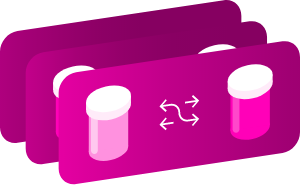Identification
- 通用名称
- Atrazine
- DrugBank Accession Number
- DB07392
- Background
-
Atrazine is a selective triazine herbicide. Inhalation hazard is low and there are no apparent skin manifestations or other toxicity in humans. Acutely poisoned sheep and cattle may show muscular spasms, fasciculations, stiff gait, increased respiratory rates, adrenal degeneration, and congestion of the lungs, liver, and kidneys. (From The Merck Index, 11th ed)
- Type
- Small Molecule
- Groups
- Experimental
- Structure
- Weight
-
Average: 215.683
米onoisotopic: 215.09377318 - Chemical Formula
- C8H14ClN5
- Synonyms
- Not Available
- External IDs
-
- G-30027
Pharmacology
- Indication
-
Not Available
 Reduce drug development failure ratesBuild, train, & validate machine-learning models
Reduce drug development failure ratesBuild, train, & validate machine-learning models
with evidence-based and structured datasets.Build, train, & validate predictive machine-learning models with structured datasets. - Contraindications & Blackbox Warnings
-
 Avoid life-threatening adverse drug eventsImprove clinical decision support with information oncontraindications & blackbox warnings, population restrictions, harmful risks, & more.Avoid life-threatening adverse drug events & improve clinical decision support.
Avoid life-threatening adverse drug eventsImprove clinical decision support with information oncontraindications & blackbox warnings, population restrictions, harmful risks, & more.Avoid life-threatening adverse drug events & improve clinical decision support. - Pharmacodynamics
-
Not Available
- 米echanism of action
-
Target Actions Organism UPhotosynthetic reaction center cytochrome c subunit Not Available Rhodopseudomonas viridis UReaction center protein H chain Not Available Rhodopseudomonas viridis UReaction center protein L chain Not Available Rhodopseudomonas viridis UReaction center protein M chain Not Available Rhodopseudomonas viridis - Absorption
-
Not Available
- Volume of distribution
-
Not Available
- Protein binding
-
Not Available
- 米etabolism
- Not Available
- Route of elimination
-
Not Available
- Half-life
-
Not Available
- Clearance
-
Not Available
- Adverse Effects
-
 Improve decision support & research outcomesWith structured adverse effects data, including:blackbox warnings, adverse reactions, warning & precautions, & incidence rates.Improve decision support & research outcomes with our structured adverse effects data.
Improve decision support & research outcomesWith structured adverse effects data, including:blackbox warnings, adverse reactions, warning & precautions, & incidence rates.Improve decision support & research outcomes with our structured adverse effects data. - Toxicity
-
Not Available
- Pathways
- Not Available
- Pharmacogenomic Effects/ADRsBrowse all" title="" id="snp-actions-info" class="drug-info-popup" href="javascript:void(0);">
- Not Available
Interactions
- Drug InteractionsLearn More" title="" id="structured-interactions-info" class="drug-info-popup" href="javascript:void(0);">
-
这些信息不应该被解释the help of a healthcare provider. If you believe you are experiencing an interaction, contact a healthcare provider immediately. The absence of an interaction does not necessarily mean no interactions exist.Not Available
- Food Interactions
- Not Available
Categories
- Drug Categories
- Chemical TaxonomyProvided byClassyfire
-
- Description
- This compound belongs to the class of organic compounds known as chloro-s-triazines. These are aromatic compounds containing a 1,3,5-triazine ring that is substituted at the 2-position with a chlorine atom.
- Kingdom
- Organic compounds
- Super Class
- Organoheterocyclic compounds
- Class
- Triazines
- Sub Class
- 1,3,5-triazines
- Direct Parent
- Chloro-s-triazines
- Alternative Parents
- Aryl chlorides/Heteroaromatic compounds/Azacyclic compounds/Organopnictogen compounds/Organonitrogen compounds/Organochlorides/Hydrocarbon derivatives
- Substituents
- Aromatic heteromonocyclic compound/Aryl chloride/Aryl halide/Azacycle/Chloro-s-triazine/Heteroaromatic compound/Hydrocarbon derivative/Organic nitrogen compound/Organochloride/Organohalogen compound
- 米olecular Framework
- Aromatic heteromonocyclic compounds
- External Descriptors
- diamino-1,3,5-triazine, chloro-1,3,5-triazine (CHEBI:15930)/Triazine herbicides (C06551)/s-triazine (ATRAZINE)
- Affected organisms
- Not Available
Chemical Identifiers
- UNII
- QJA9M5H4IM
- CAS number
- 1912-24-9
- InChI Key
- 米XWJVTOOROXGIU-UHFFFAOYSA-N
- InChI
-
InChI=1S/C8H14ClN5/c1-4-10-7-12-6(9)13-8(14-7)11-5(2)3/h5H,4H2,1-3H3,(H2,10,11,12,13,14)
- IUPAC Name
-
6-chloro-N2-ethyl-N4-(propan-2-yl)-1,3,5-triazine-2,4-diamine
- SMILES
-
CCNC1=NC(NC(C)C)=NC(Cl)=N1
References
- 一般引用
- Not Available
- External Links
-
- Human Metabolome Database
- HMDB0041830
- KEGG Compound
- C06551
- PubChem Compound
- 2256
- PubChem Substance
- 99443863
- ChemSpider
- 2169
- ChEBI
- 15930
- ChEMBL
- CHEMBL15063
- ZINC
- ZINC000003078958
- PDBe Ligand
- ATZ
- Wikipedia
- Atrazine
- PDB Entries
- 5prc
Clinical Trials
- Clinical TrialsLearn More" title="" id="clinical-trials-info" class="drug-info-popup" href="javascript:void(0);">
-
Phase Status Purpose Conditions Count
Pharmacoeconomics
- 米anufacturers
-
Not Available
- Packagers
-
Not Available
- Dosage Forms
- Not Available
- Prices
- Not Available
- Patents
- Not Available
Properties
- State
- Solid
- Experimental Properties
- Not Available
- Predicted Properties
-
Property Value Source Water Solubility 0.0275 mg/mL ALOGPS logP 2.7 ALOGPS logP 2.2 Chemaxon logS -3.9 ALOGPS pKa (Strongest Acidic) 14.48 Chemaxon pKa (Strongest Basic) 4.2 Chemaxon Physiological Charge 0 Chemaxon Hydrogen Acceptor Count 5 Chemaxon Hydrogen Donor Count 2 Chemaxon Polar Surface Area 62.73 Å2 Chemaxon Rotatable Bond Count 4 Chemaxon Refractivity 62.22 m3·mol-1 Chemaxon Polarizability 22.58 Å3 Chemaxon Number of Rings 1 Chemaxon Bioavailability 1 Chemaxon Rule of Five Yes Chemaxon Ghose Filter Yes Chemaxon Veber's Rule No Chemaxon 米DDR-like Rule No Chemaxon - Predicted ADMET Features
-
Property Value Probability Human Intestinal Absorption + 0.9919 Blood Brain Barrier + 0.8417 Caco-2 permeable + 0.5291 P-glycoprotein substrate Non-substrate 0.6251 P-glycoprotein inhibitor I Non-inhibitor 0.8782 P-glycoprotein inhibitor II Non-inhibitor 0.8382 Renal organic cation transporter Non-inhibitor 0.7862 CYP450 2C9 substrate Non-substrate 0.8684 CYP450 2D6 substrate Non-substrate 0.7857 CYP450 3A4 substrate Non-substrate 0.5933 CYP450 1A2 substrate Inhibitor 0.8329 CYP450 2C9 inhibitor Non-inhibitor 0.9162 CYP450 2D6 inhibitor Non-inhibitor 0.734 CYP450 2C19 inhibitor Non-inhibitor 0.5562 CYP450 3A4 inhibitor Non-inhibitor 0.8978 CYP450 inhibitory promiscuity Low CYP Inhibitory Promiscuity 0.756 Ames test Non AMES toxic 0.9252 Carcinogenicity Non-carcinogens 0.8064 Biodegradation Not ready biodegradable 0.9957 Rat acute toxicity 2.4745 LD50, mol/kg Not applicable hERG inhibition (predictor I) Weak inhibitor 0.8636 hERG inhibition (predictor II) Non-inhibitor 0.8369
Spectra
- 米ass Spec (NIST)
- Not Available
- Spectra
Targets

Build, predict & validate machine-learning models
Use our structured and evidence-based datasets tounlock new
insights and accelerate drug research.
insights and accelerate drug research.
Use our structured and evidence-based datasets to unlock new insights and accelerate drug research.
- Kind
- Protein
- Organism
- Rhodopseudomonas viridis
- Pharmacological action
-
Unknown
- General Function
- Iron ion binding
- Specific Function
- The reaction center of purple bacteria contains a tightly bound cytochrome molecule which re-reduces the photo oxidized primary electron donor.
- Gene Name
- pufC
- Uniprot ID
- P07173
- Uniprot Name
- Photosynthetic reaction center cytochrome c subunit
- 分子量
- 39370.915哒
References
- Berman HM, Westbrook J, Feng Z, Gilliland G, Bhat TN, Weissig H, Shindyalov IN, Bourne PE: The Protein Data Bank. Nucleic Acids Res. 2000 Jan 1;28(1):235-42. [Article]
- Kind
- Protein
- Organism
- Rhodopseudomonas viridis
- Pharmacological action
-
Unknown
- General Function
- Electron transporter, transferring electrons within the cyclic electron transport pathway of photosynthesis activity
- Specific Function
- The reaction center is a membrane-bound complex that mediates the initial photochemical event in the electron transfer process of photosynthesis.
- Gene Name
- puhA
- Uniprot ID
- P06008
- Uniprot Name
- Reaction center protein H chain
- 分子量
- 28498.245 Da
References
- Berman HM, Westbrook J, Feng Z, Gilliland G, Bhat TN, Weissig H, Shindyalov IN, Bourne PE: The Protein Data Bank. Nucleic Acids Res. 2000 Jan 1;28(1):235-42. [Article]
- Kind
- Protein
- Organism
- Rhodopseudomonas viridis
- Pharmacological action
-
Unknown
- General Function
- 米etal ion binding
- Specific Function
- The reaction center is a membrane-bound complex that mediates the initial photochemical event in the electron transfer process of photosynthesis.
- Gene Name
- pufL
- Uniprot ID
- P06009
- Uniprot Name
- Reaction center protein L chain
- 分子量
- 30578.225 Da
References
- Berman HM, Westbrook J, Feng Z, Gilliland G, Bhat TN, Weissig H, Shindyalov IN, Bourne PE: The Protein Data Bank. Nucleic Acids Res. 2000 Jan 1;28(1):235-42. [Article]
- Kind
- Protein
- Organism
- Rhodopseudomonas viridis
- Pharmacological action
-
Unknown
- General Function
- 米etal ion binding
- Specific Function
- The reaction center is a membrane-bound complex that mediates the initial photochemical event in the electron transfer process of photosynthesis.
- Gene Name
- pufM
- Uniprot ID
- P06010
- Uniprot Name
- Reaction center protein M chain
- 分子量
- 36035.285 Da
References
- Berman HM, Westbrook J, Feng Z, Gilliland G, Bhat TN, Weissig H, Shindyalov IN, Bourne PE: The Protein Data Bank. Nucleic Acids Res. 2000 Jan 1;28(1):235-42. [Article]
Drug created at September 15, 2010 21:21 / Updated at June 12, 2020 16:52



